青少年和成人发病亨廷顿病临床谱的比较:一项国家队列和入组亨廷顿病观察性研究
IF 7.7
1区 医学
Q1 CLINICAL NEUROLOGY
引用次数: 0
摘要
背景与目的:青少年发病的亨廷顿病(JHD)和成人发病的亨廷顿病(AHD)临床特征的差异是假设的,但没有直接比较。本研究比较了发病年龄(AO)亚型的临床特征、发生率和严重程度。方法:使用国家青少年发病的HD患者队列和国际注册的HD登记处(NCT01574053),我们比较了儿童发病的JHD (cJHD;AO 0-10),青少年发病的JHD (aJHD;AO 11-20)和成人发病HD (AHD;AO 21-65)在合并数据集中发病时的临床特征和精神特征的比例。采用Kruskal-Wallis检验对注册- hd数据集的uhdrs -总运动评分(UHDRS-TMS)项目进行比较,比较发病后6-10年运动疾病特征的严重程度。结果cJHD患者46例(平均AO值6.70,女性45%),aJHD患者243例(平均AO值16.70,女性46%),AHD患者9504例(平均AO值44.70,女性51%)。发病时,47.50%的cJHD患者出现神经认知症状(n = 46;95% CI 31.80%-63.70%),明显高于24.88%的aJHD患者(n = 209;19.30% ~ 31.40%), AHD患者占15.02% (n = 8177;14.30% - -15.80%)。aJHD患者出现精神症状的比例为47.12% (95% CI 40.20% ~ 54.10%),明显高于AHD患者的31.04%(30.10% ~ 32.00%)。在整个疾病过程中,73.91%的cJHD患者发生了攻击行为(n = 46;95% CI 58.60%-85.20%)和55.88%的aJHD患者(n = 238;49.30%-62.30%),明显高于AHD患者的40.65% (n = 9501;39.70% - -41.70%)。aJHD患者出现精神病的比例为23.53% (95% CI 18.40% ~ 29.50%),明显高于AHD患者的12.77%(12.10% ~ 13.50%)。Kruskal-Wallis检验显示,与AHD相比,JHD一种或两种亚型的UHDRS-TMS评分中位数显著高于构音障碍(AHD: n = 4,163,中位数1.00,四分位间距(IQR) 0.70;cJHD: n = 12,2.20, 2.00, p = 0.039;aJHD: n = 93, 1.00, 1.00, p = 0.031),帕金森病(AHD: n = 4158,中位值6.00,IQR 4.70;cJHD: n = 12, 11.00, 9.40, p = 0.008;aJHD: n = 93, 8.50, 6.80, p < 0.001)和肌张力障碍(AHD: n = 4161,中位数2.00,IQR 5.20;cJHD: n = 12, 6.50, 8.20, p = 0.141;aJHD: n = 93, 4.00, 7.20, p = 0.015),而舞蹈病的中位评分显著低于AHD (n = 4163,中位9.20,IQR 7.00;cJHD: n = 12, 5.00, 4.20, p = <0.001;aJHD: n = 93, 6.30, 9.50, p < 0.001)。本研究强调了与多动症相比,JHD亚型的不同临床模式。在未来的研究中,需要根据发病年龄进行分层——确定HD亚型。本文章由计算机程序翻译,如有差异,请以英文原文为准。
Comparison of the Clinical Spectrum of Juvenile- and Adult-Onset Huntington Disease: A National Cohort and Enroll-HD Observational Study.
BACKGROUND AND OBJECTIVES
Differences in clinical characteristics between juvenile-onset Huntington disease (JHD) and adult-onset HD (AHD) are hypothesized but not directly compared. This study compares clinical characteristics occurrence and severity across age-at-onset (AO) subtypes.
METHODS
Using the national juvenile-onset HD patient cohort and the international Enroll-HD registry (NCT01574053), we compared childhood-onset JHD (cJHD; AO 0-10), adolescent-onset JHD (aJHD; AO 11-20), and adult-onset HD (AHD; AO 21-65) on proportions of clinical characteristics at onset and psychiatric characteristics in pooled datasets. Kruskal-Wallis test was applied to UHDRS-Total Motor Score (UHDRS-TMS) items of the Enroll-HD dataset to compare the severity of motor disease characteristics 6-10 years after onset.
RESULTS
The combined datasets provided data from 46 patients with cJHD (mean AO 6.70, 45% female), 243 patients with aJHD (mean AO 16.70, 46% female), and 9,504 patients with AHD (mean AO 44.70, 51% female). At onset, neurocognitive symptoms occurred in 47.50% of patients with cJHD (n = 46; 95% CI 31.80%-63.70%), significantly more often compared with 24.88% of patients with aJHD (n = 209; 19.30%-31.40%) and 15.02% of those with AHD (n = 8,177; 14.30%-15.80%). Psychiatric symptoms occurred in 47.12% of patients with aJHD (95% CI 40.20%-54.10%), significantly more compared with 31.04% of patients with AHD (30.10%-32.00%). Throughout the disease, aggressive behavior occurred in 73.91% of patients with cJHD (n = 46; 95% CI 58.60%-85.20%) and 55.88% of those with aJHD (n = 238; 49.30%-62.30%), significantly more compared with 40.65% of patients with AHD (n = 9,501; 39.70%-41.70%). Psychosis occurred in 23.53% of patients with aJHD (95% CI 18.40%-29.50%), significantly more compared with 12.77% of those with AHD (12.10%-13.50%). The Kruskal-Wallis test revealed significantly higher median UHDRS-TMS scores in one or both JHD subtypes compared with AHD for dysarthria (AHD: n = 4,163, median 1.00, interquartile range (IQR) 0.70; cJHD: n = 12, 2.20, 2.00, p = 0.039; aJHD: n = 93, 1.00, 1.00, p = 0.031), parkinsonism (AHD: n = 4,158, median 6.00, IQR 4.70; cJHD: n = 12, 11.00, 9.40, p = 0.008; aJHD: n = 93, 8.50, 6.80, p < 0.001), and dystonia (AHD: n = 4,161, median 2.00, IQR 5.20; cJHD: n = 12, 6.50, 8.20, p = 0.141; aJHD: n = 93, 4.00, 7.20, p = 0.015) and significantly lower median scores for chorea (AHD: n = 4,163, median 9.20, IQR 7.00; cJHD: n = 12, 5.00, 4.20, p = <0.001; aJHD: n = 93, 6.30, 9.50, p < 0.001).
DISCUSSION
This study highlights distinct clinical patterns in JHD subtypes compared with AHD. Stratification by age at onset-defined HD subtypes is needed in future studies.
求助全文
通过发布文献求助,成功后即可免费获取论文全文。
去求助
来源期刊

Neurology
医学-临床神经学
CiteScore
12.20
自引率
4.00%
发文量
1973
审稿时长
2-3 weeks
期刊介绍:
Neurology, the official journal of the American Academy of Neurology, aspires to be the premier peer-reviewed journal for clinical neurology research. Its mission is to publish exceptional peer-reviewed original research articles, editorials, and reviews to improve patient care, education, clinical research, and professionalism in neurology.
As the leading clinical neurology journal worldwide, Neurology targets physicians specializing in nervous system diseases and conditions. It aims to advance the field by presenting new basic and clinical research that influences neurological practice. The journal is a leading source of cutting-edge, peer-reviewed information for the neurology community worldwide. Editorial content includes Research, Clinical/Scientific Notes, Views, Historical Neurology, NeuroImages, Humanities, Letters, and position papers from the American Academy of Neurology. The online version is considered the definitive version, encompassing all available content.
Neurology is indexed in prestigious databases such as MEDLINE/PubMed, Embase, Scopus, Biological Abstracts®, PsycINFO®, Current Contents®, Web of Science®, CrossRef, and Google Scholar.
 求助内容:
求助内容: 应助结果提醒方式:
应助结果提醒方式:


